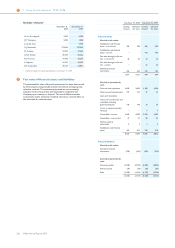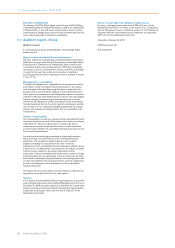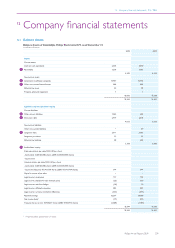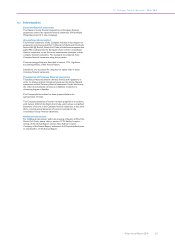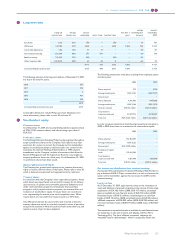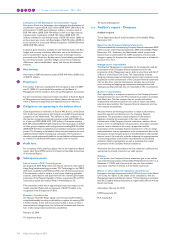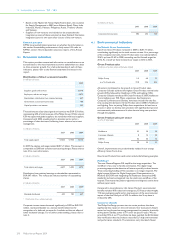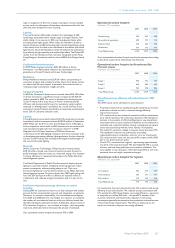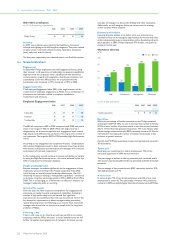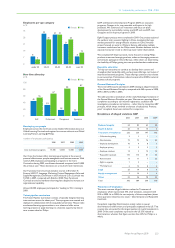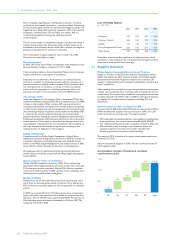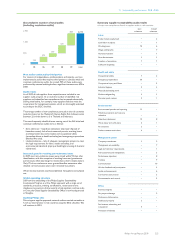Philips 2009 Annual Report Download - page 215
Download and view the complete annual report
Please find page 215 of the 2009 Philips annual report below. You can navigate through the pages in the report by either clicking on the pages listed below, or by using the keyword search tool below to find specific information within the annual report.
13 Sustainability performance
13.1 Approach to sustainability reporting
Philips has a long tradition of sustainability reporting, beginning in 1999
when we published our first environmental annual report. We
expanded our reporting in 2003 with the launch of our first
sustainability annual report, which provided details on our social and
economic performance in addition to our environmental results.
In 2010 we published our second integrated financial, social and
environmental report, reflecting the progress we have made to embed
sustainability in our way of doing business.
Reporting standards
We have followed relevant best practice standards and international
guidelines while compiling the sustainability performance covered in
this report. Most important are the Global Reporting Initiative’s (GRI)
G3 Sustainability Reporting Guidelines.
With regard to the GRI Application Levels system, we assessed
ourselves at the A+ level. A detailed overview of our Management
Approach and the G3 Core Indicators is provided at the end of this
section.
We signed on to the United Nations Global Compact in March 2007,
joining thousands of companies from all regions of the world,
international labor and civil society organizations to advance 10
universal principles in the areas of human rights, labor, the environment
and anti-corruption. Our General Business Principles, Sustainability and
Environmental Policies, and our Supplier Sustainability Declaration are
the cornerstones that enable us to live up to the standards set by the
Global Compact. This is closely monitored and reported, as illustrated
throughout this report, which is our annual Communication on
Progress (COP) submitted to the UN Global Compact Office.
Tracking Trends
We continuously follow external trends to determine the issues most
relevant for our company and those where we can make a positive
contribution to society at large. In addition to our own research, we
make use of a variety of sources, including the World Bank, World
Business Council for Sustainable Development (WBCSD), World
Economic Forum and World Health Organization. Our work also
involves tracking topics of concern to governments, regulatory bodies
and non-governmental organizations, and following the resulting media
coverage.
Stakeholder engagement
Across all our activities we seek to engage stakeholders to gain their
feedback on specific areas of our business. Working in partnerships is
crucial in delivering on our commitment of bringing “sense and
simplicity” to people’s health and well-being. We participate in meetings
and task forces as a member of organizations including the WBCSD;
Electronic Industry Citizenship Coalition (EICC); European Committee
of Domestic Equipment Manufacturers (CECED); Federation of
National Manufacturers Associations for Luminaires and
Electrotechnical Components for Luminaires in the European Union
(CELMA); European Coordination Committee of the Radiological,
Electromedical and Healthcare IT Industry (COCIR); Digital Europe;
European Lamp Companies Federation (ELC); European Roundtable of
Industrialists (ERT); National Electrical Manufacturers Association
(NEMA); Environmental Leadership Council of the Information
Technology Industry Council (ELC ITIC); Consumer Electronics
Association (CEA); and Association of Home Appliance Manufacturers
(AHAM).
In 2009 we established a dedicated Professional and Public Affairs team
to further steer and professionalize our stakeholder engagement
activities with key business influencers including government, non-
governmental institutions, industry associations, industry partners,
influencers and opinion formers across the company.
The Philips Center for Health and Well-being
Through the creation of the Philips Center for Health and Well-being,
Philips seeks to address key societal issues and solutions on themes
such as home healthcare, preventive health, sleep, independent living
and livable cities. The Center launched in December 2009 with a
consultation event on the theme of ‘Keeping cities livable and healthy’.
A diverse group of experts from multiple disciplines came together to
discuss the underlying trends and important issues around keeping
cities livable in the face of rapid urbanization. The session sparked
debate and dialogue, and illustrated what a broad and diverse topic
livable cities is, exploring areas like bringing nature back to cities,
improving public spaces for social life and civic engagement, as well as
renovating buildings. The event also provided input and feedback into
how to develop the Center further with a global think tank on this
theme.
Working on global issues
Philips participated in the 2009 United Nations Climate Change
Conference in Copenhagen, seeking dialogue with organizations
including the Corporate Leadership Group, Responding to Climate
Change and the Climate Summit for Mayors, and calling upon
government worldwide to set ambitious targets for emission
reductions with efficient technologies available today.
Philips also signed a global partnership with IUCN, the International
Union for the Conservation of Nature. Together we will explore
further how specific lighting technology can redress the disturbance of
fauna around the world enabling it to co-exist with human sea and
coastal development for instance.
Philips Research held two events in 2009 that brought a variety of
stakeholders together to explore innovation for sustainable
development. On ‘Disruption Day’ in March experts from the United
Nations University in Maastricht, IUCN and the Innovation Leadership
Forum shared their perspectives on the disruptive innovation
challenges ahead. This was followed up with ‘Connection Day’ in
December, attended by 50 Philips employees, academics from the New
York Academy of Sciences, representatives of institutions like the Earth
Institute, the International Labor Organization and the emerging Green
Economy Coalition, museum curators, employees of small and medium-
sized enterprises, and engaged citizens. They explored the six themes –
energy, materials, access to care, value-redefined, transitions and co-
creation – seeking new ideas through new connections.
Material issues and our focus
Based on ongoing trend analysis and stakeholder input, we identify the
key material issues for our company. We have mapped relevant risks
and opportunities in the table below, taking into account the:
• level of concern to society at large and stakeholders, versus impact
on Philips, or
• level of control or influence we can have on an issue through our
operations and products/solutions.
This is a dynamic process, as we continuously monitor the world
around us.
13 Sustainability performance 13 - 13.1
Philips Annual Report 2009 215



